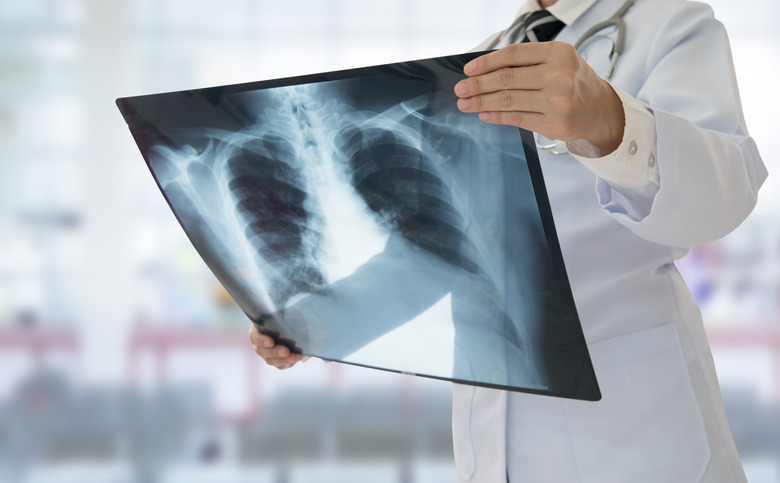The Respiratory & Circulatory System In The Human Body
The human respiratory and circulatory systems work together to supply the body with oxygen and get rid of waste carbon dioxide. While the former deals with air and the latter with blood, they work together seamlessly by coordinating the functions of the many parts of each system. Other systems in the body, such as the digestive system and the nervous system, are important too, but the circulatory and respiratory systems have to work continuously, usually without pausing even for a few minutes.
TL;DR (Too Long; Didn't Read)
The circulatory and respiratory systems absorb oxygen from the air and transfer it to all parts of the body while absorbing carbon dioxide from the body and releasing it into the air. When a person inhales, the lungs expand and fill with fresh air. The respiratory system interacts with the circulatory system to transfer oxygen from fresh air to red blood cells in the lung arteries while also releasing carbon dioxide from the blood into the air in the lungs. When a person exhales, this used air leaves the body. The heart pumps the blood with the oxygenated red blood cells from the lungs via the arteries throughout the body where the oxygen is released into the cells and carbon dioxide is absorbed. The heart pumps the used blood back through the veins to the lungs, and the cycle repeats itself.
Major Organs Make the Circulatory and Respiratory Systems Work
Major Organs Make the Circulatory and Respiratory Systems Work
The major organ of the circulatory system is the heart, which pumps the blood into the lungs and throughout the body. The arteries take the blood from the heart out to the different organs. The final distribution to individual cells is carried out via small blood vessels called capillaries. From the cells, the blood returns to the heart via veins, and from the heart, the blood is pumped back to the lungs.
The major organs of the respiratory system are the lungs. When the lungs expand, the body inhales fresh air, which is passed down from the mouth or nose through the trachea into the bronchial tubes of the lungs and into the tiny alveoli air sacs. There, the oxygen from the air is absorbed by the red blood cells of the circulatory system arteries while the carbon dioxide in the blood is released into the air in the air sacs. When the lung contracts, the body exhales the used air and takes a new breath.
Respiratory System Interactions With the Circulatory System
Respiratory System Interactions With the Circulatory System
The circulatory or cardiovascular system's ability to deliver oxygen throughout the body depends on proper functioning of the respiratory system. The interactions between the cardiovascular and respiratory systems are best demonstrated by following the path of a red blood cell starting in the heart and traveling through the lungs.
A red blood cell that has just returned from delivering oxygen and that has brought back carbon dioxide would be in the right upper chamber of the heart or in the right atrium. When the atrium contracts, the cell is pumped into the right lower chamber of the heart, or the right ventricle. When that ventricle contracts, the red blood cell is pumped out of the heart through the pulmonary artery to the lungs.
In the lungs, the red blood cell enters tiny blood vessels that come into close contact with the walls of the alveoli air sacs of the lungs. The carbon dioxide in the red blood cell passes through the walls into the alveoli while the oxygen in the alveoli air passes into the red blood cell. The red blood cell then returns to the heart via the pulmonary vein.
From the pulmonary vein, the red blood cell enters the left atrium of the heart and then the left ventricle. The part of the heart muscle powering the left ventricle is very strong because it has to push the blood out to the whole body. The red blood cell is pumped out of the left ventricle via the aorta artery and eventually reaches the capillaries leading to the individual cells. There the cells absorb the oxygen from the red blood cell and pass on their waste carbon dioxide. The red blood cell returns to the right atrium of the heart via the veins to complete the cycle.
These circulatory and respiratory system interactions are ones that humans and higher animals such as mammals and birds share and that represent one of the basic functions of their bodies. Only when these two systems work and interact properly can the human or animal carry out other functions such as looking for food or reproducing.
Cite This Article
MLA
Markgraf, Bert. "The Respiratory & Circulatory System In The Human Body" sciencing.com, https://www.sciencing.com/respiratory-circulatory-system-human-body-6655803/. 20 July 2018.
APA
Markgraf, Bert. (2018, July 20). The Respiratory & Circulatory System In The Human Body. sciencing.com. Retrieved from https://www.sciencing.com/respiratory-circulatory-system-human-body-6655803/
Chicago
Markgraf, Bert. The Respiratory & Circulatory System In The Human Body last modified March 24, 2022. https://www.sciencing.com/respiratory-circulatory-system-human-body-6655803/
